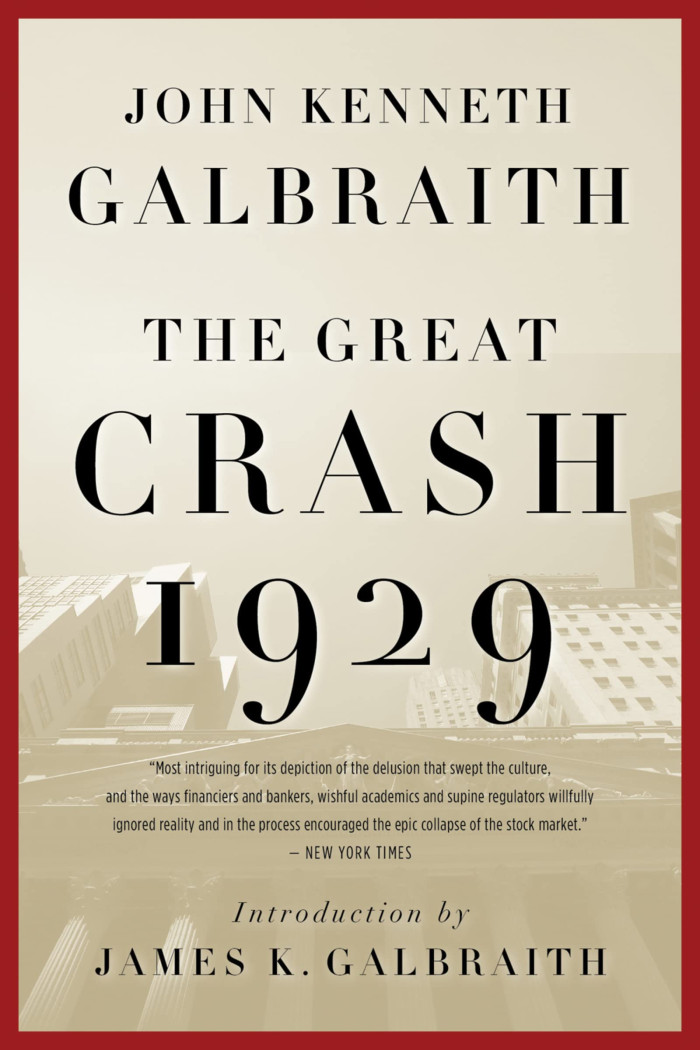
Support the author by purchasing this book with the link below!
PurchaseThe Great Crash 1929
John Kenneth Galbraith
Published: 1955
"The Great Crash 1929" by John Kenneth Galbraith is a non-fiction book that provides a detailed analysis of the events leading up to the stock market crash of 1929 and the subsequent economic depression.
The book begins by examining the economic policies and practices of the 1920s, which set the stage for the speculative bubble that formed in the stock market. Galbraith argues that the widespread belief in the market's infallibility and the promotion of speculative investments by banks and investment trusts led to the overvaluation of stocks and the creation of a speculative bubble.
The book then delves into the psychological and emotional factors that contributed to the market's instability. Galbraith discusses the role of optimism, overconfidence, and herd behavior among investors, which fueled the market's growth but also contributed to its eventual collapse.
Galbraith provides a detailed account of the events leading up to the crash, including the increasing volume of stock purchases on margin, the rising level of corporate debt, and the growing number of investment trusts. He also explores the role of financial institutions and regulators, such as the Federal Reserve, in contributing to the market's instability.
The book then describes the immediate aftermath of the crash, including the widespread panic and sell-off of stocks. Galbraith explains how the stock market crash led to a decline in consumer confidence, a contraction of credit, and a deepening economic depression.
Galbraith concludes the book by discussing the lessons that can be learned from the crash and the need for sound economic policies and regulations to prevent future financial disasters. He argues that the events of 1929 demonstrate the dangers of unchecked speculation and the need for responsible financial practices and regulation.
The book begins by examining the economic policies and practices of the 1920s, which set the stage for the speculative bubble that formed in the stock market. Galbraith argues that the widespread belief in the market's infallibility and the promotion of speculative investments by banks and investment trusts led to the overvaluation of stocks and the creation of a speculative bubble.
The book then delves into the psychological and emotional factors that contributed to the market's instability. Galbraith discusses the role of optimism, overconfidence, and herd behavior among investors, which fueled the market's growth but also contributed to its eventual collapse.
Galbraith provides a detailed account of the events leading up to the crash, including the increasing volume of stock purchases on margin, the rising level of corporate debt, and the growing number of investment trusts. He also explores the role of financial institutions and regulators, such as the Federal Reserve, in contributing to the market's instability.
The book then describes the immediate aftermath of the crash, including the widespread panic and sell-off of stocks. Galbraith explains how the stock market crash led to a decline in consumer confidence, a contraction of credit, and a deepening economic depression.
Galbraith concludes the book by discussing the lessons that can be learned from the crash and the need for sound economic policies and regulations to prevent future financial disasters. He argues that the events of 1929 demonstrate the dangers of unchecked speculation and the need for responsible financial practices and regulation.
1. Speculation and overconfidence can lead to a financial bubble, and eventually a crash.
2. Financial institutions and investors played a significant role in the events leading up to the crash, through their actions and policies.
3. The psychological and emotional factors of investors can also influence market behavior and contribute to financial instability.
4. The crash had widespread economic and social consequences, including a deep and prolonged depression.
5. The need for sound economic policies and regulations to prevent future financial disasters.
2. Financial institutions and investors played a significant role in the events leading up to the crash, through their actions and policies.
3. The psychological and emotional factors of investors can also influence market behavior and contribute to financial instability.
4. The crash had widespread economic and social consequences, including a deep and prolonged depression.
5. The need for sound economic policies and regulations to prevent future financial disasters.
"The Great Crash 1929" is a non-fiction book written by John Kenneth Galbraith that provides a detailed analysis of the events that led to the stock market crash of 1929, which is considered one of the most catastrophic financial events in history. The book offers a critical examination of the social and economic factors that contributed to the crash and the subsequent economic depression of the 1930s.
Galbraith's account of the events leading up to the crash provides an in-depth look at the various economic policies and practices that allowed for a speculative bubble to form in the stock market. The book highlights the role played by the investment trusts, banks, and other financial institutions in facilitating the market's growth and eventual collapse. Additionally, Galbraith offers insights into the psychological and emotional factors that influenced investor behavior during this time.
"The Great Crash 1929" is widely regarded as a classic of financial literature, offering a cautionary tale about the dangers of unchecked speculation and the need for sound economic policies to prevent future financial disasters. It remains relevant to contemporary discussions about the regulation of financial markets and the potential risks associated with excessive speculation and financialization.
Galbraith's account of the events leading up to the crash provides an in-depth look at the various economic policies and practices that allowed for a speculative bubble to form in the stock market. The book highlights the role played by the investment trusts, banks, and other financial institutions in facilitating the market's growth and eventual collapse. Additionally, Galbraith offers insights into the psychological and emotional factors that influenced investor behavior during this time.
"The Great Crash 1929" is widely regarded as a classic of financial literature, offering a cautionary tale about the dangers of unchecked speculation and the need for sound economic policies to prevent future financial disasters. It remains relevant to contemporary discussions about the regulation of financial markets and the potential risks associated with excessive speculation and financialization.
Reviews
-

A Timeless Classic That Illuminates the Dangers of Unchecked Speculation
Published 2 years ago by fulcrum-security
In "The Great Crash 1929," John Kenneth Galbraith provides a masterful analysis of one of the most catastrophic events in financial history. With meticulous research and keen insight, Galbraith examines the economic policies and practices that contributed to the stock market crash of 1929 and the subsequent economic depression. Galbraith's analysis of the events leading...
Read Review
